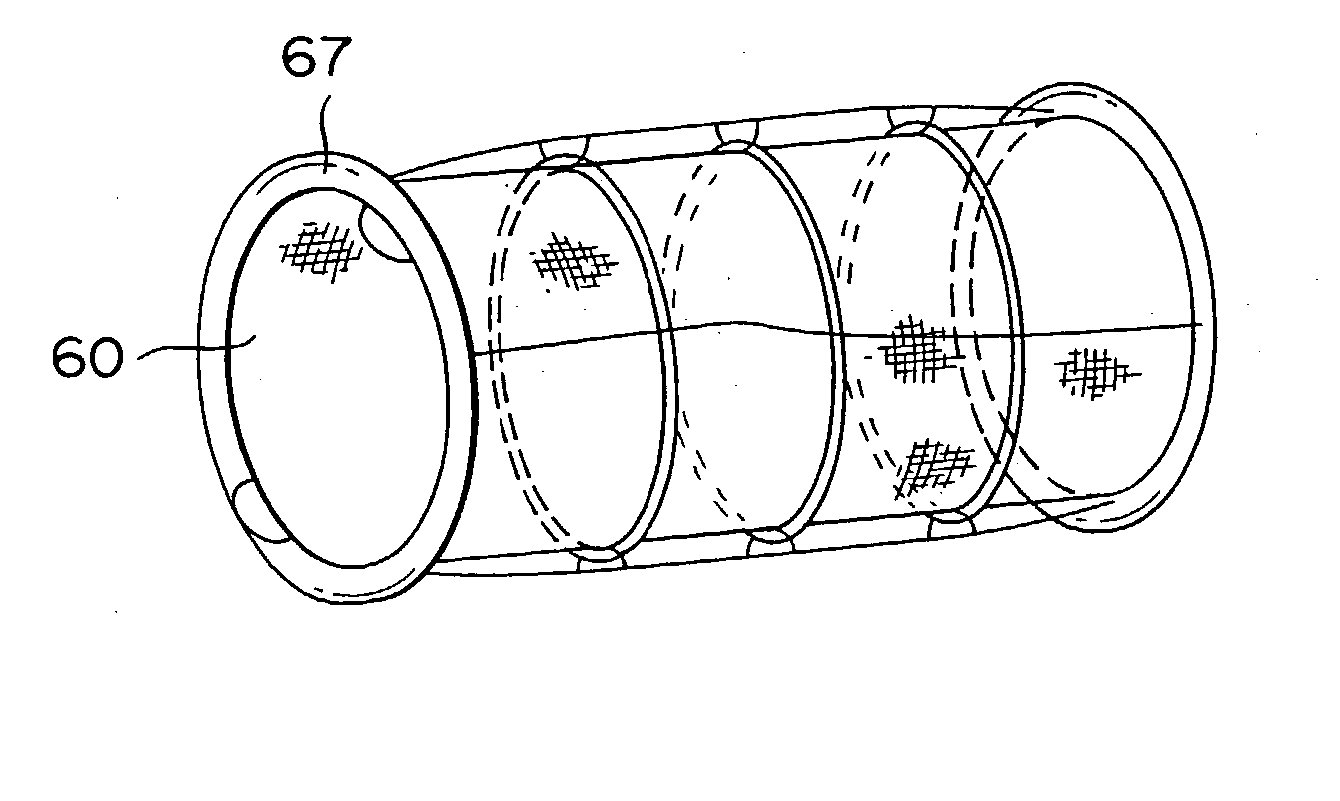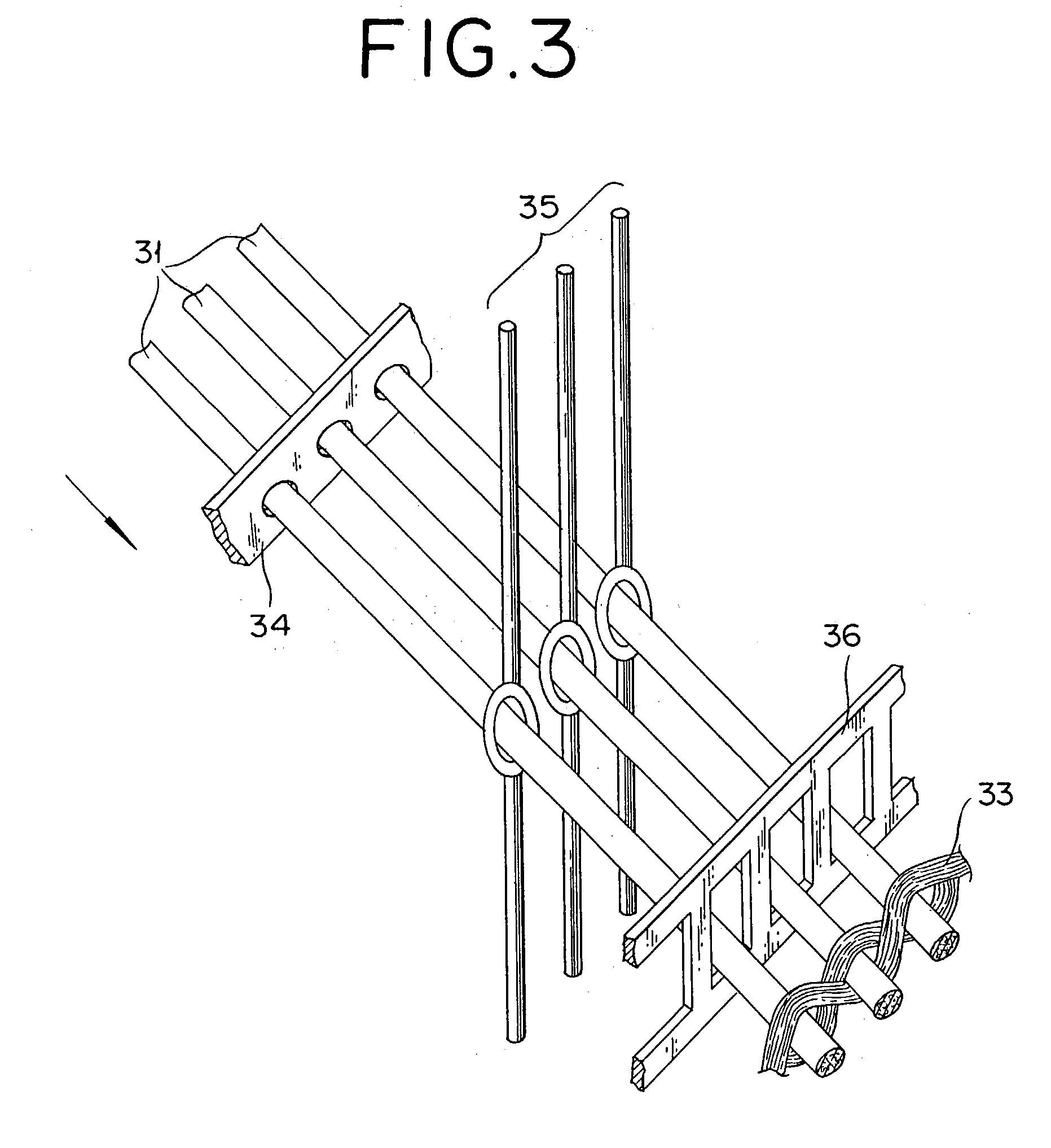In particular on the part of old people who suffer from chronic diseases, the application of this surgical operation has been restricted because of inducing a complication.
However, the stent type blood vascular prosthesis has limited folding ability and insufficient adaptability to curved blood vessels in human bodies because it is inferior in flexibility to the blood vascular prosthesis that is devoid of stent.
That is to say, the wire rings themselves have no ability whatever to
resist the crush exerted in the direction of the length of the device.
When the wire rings are combined with the conventional surface member which pays no consideration to the crush, therefore, this combination could possibly constitute a fatal defect because the flow of blood crushes the implanting device and the blood flows through the gap in the terminal part into the
lesion.
The use of a monofilament for warps, however, has given rise to another problem that the interlacing parts of warps and wefts are liable to form gaps.
In contrast, when a monofilament is used for either or both of warps and wefts, the formation of gaps is apt to occur because the cross sections of such a monofilament are not deformed even in the interlacing parts and the warps and the wefts cannot be brought into mutual adhesion.
The gaps between the warps and the wefts may cause a marked decline in the liquid tightness.
The surface member which uses the monofilament for the warps thereof has no sufficient liquid tightness even when it uses a dense multifilament for the wefts thereof, and does not prevent the inflow of blood into the site of a lesion due to leakage of blood.
If the flattening is smaller than 1.2, the WTVP using the monofilament in at least part of the warps, will form gaps between warps and wefts, betray deficiency in liquid tightness, and fail to prevent the leakage of blood.
If the flattening is larger than 5.0, the excess will result in impairing the thread forming property and the weave forming property and degrading the stability of the commercial aspect of the operation.
If the size is smaller than 11 dtex, the shortage will result in impairing the weaving property, degrading the stability of the commercial aspect of the operation, and decreasing the stiffness.
The WTVP using the monofilament in at least part of the warps and the SBVP using the WTVP fail to acquire a sufficient shape retaining property and fail to manifest durability enough to withstand the crush in the direction of length.
If the size exceeds 250 dtex, the excess will result in increasing the wall thickness of the WTVP and unduly enlarging the stiffness and consequently rendering the WTVP and a SBVP using the WTVP difficult to fold them in a small size.
As a result, the
catheter to be used for the intravascular therapy will be required to have a large
diameter such that it may not be easily inserted into the
blood vessel or moved therein and worse still may possibly inflict an injury to the site of a lesion.
If the size of the
single filament exceeds 3.5 dtex, the
single filament, when used in combination with the present monofilament, will render the WTVP and a SBVP using the WTVP difficult to be folded in a small size because of an increased wall thickness and an increased stiffness.
If the number of the
single filament is smaller than 10, the WTVP will betray deficiency in liquid tightness and fail to prevent the leakage of blood.
If the number exceeds 1000, the filament will tend to incur troubles such as warp breakage and fluff during the course of weaving and impair the
operational stability.
If the total size is larger than 110 dtex, the WTVP and a SBVP using the WTVP will not be easily folded in a small size because of an increased wall thickness and an undue addition to stiffness.
If the monofilament to be used in the warps is notably different in a size from the other threads to be used in the warps, the WTVP will form a nonuniform surface and possibly betray deficiency in liquid tightness.
If the twist multiplier exceeds 1000 times / meter, the mutual entangling and the overlapping thereof will have adverse influences and then the WTVP will have insufficient liquid tightness.
If the ratio is smaller than 25:75, the WTVP and a SBVP using the WTVP will not acquire a sufficient shape retaining property and will offer no sufficient durability to withstand the crush in the direction of length.
If the column strength exceeds 0.130 N / mm of a
diameter, folding the WTVP and a SBVP using the WTVP into a small size will become difficult because of an increased stiffness.
If the coefficient is larger than this upper limit, the WTVP, when implanted in the site of a lesion as a SBVP, will suffer blood to leak therefrom and fail to prevent the inflow of blood into the site of the lesion.
If the wall thickness is larger than 150 .mu.m, the WTVP and a SBVP using the WTVP will not be easily folded into a small size.
If the SBVP is deficient in folding ability, it will require the
catheter used in the intravascular therapy to have a large
diameter and will lower operational efficiency.
When an
aneurysm is formed in a branching part of a vital
blood vessel, e.g., from the
abdominal aorta to the common
iliac artery, it is conceivable to perform the therapy by using a plurality of straight SBVPs, though the relevant surgical operation is complicated and consumes an unduly long time.
 Login to View More
Login to View More  Login to View More
Login to View More 


